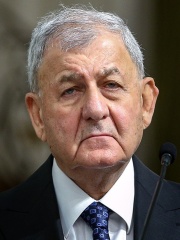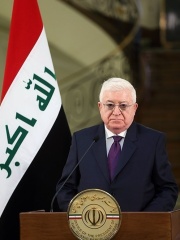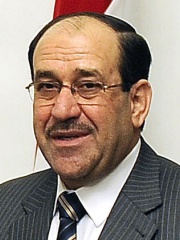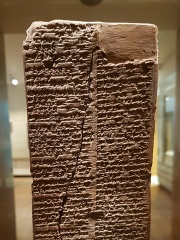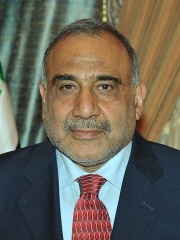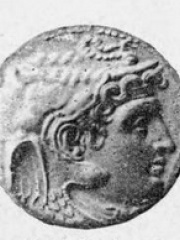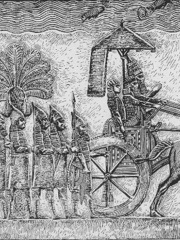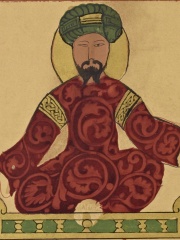
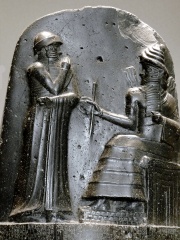
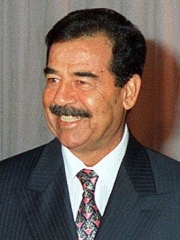
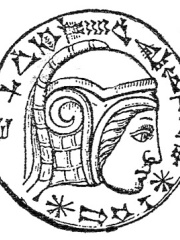
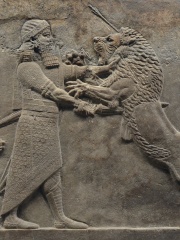

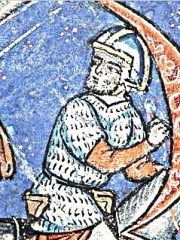
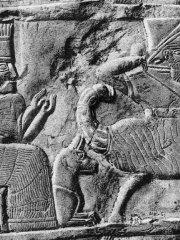
The Most Famous
POLITICIANS from Iraq
This page contains a list of the greatest Iraqi Politicians. The pantheon dataset contains 19,576 Politicians, 207 of which were born in Iraq. This makes Iraq the birth place of the 18th most number of Politicians behind Egypt, and Sweden.
Top 10
The following people are considered by Pantheon to be the top 10 most legendary Iraqi Politicians of all time. This list of famous Iraqi Politicians is sorted by HPI (Historical Popularity Index), a metric that aggregates information on a biography's online popularity. Visit the rankings page to view the entire list of Iraqi Politicians.

1. Saladin (1138 - 1193)
With an HPI of 91.36, Saladin is the most famous Iraqi Politician. His biography has been translated into 141 different languages on wikipedia.
Salah ad-Din Yusuf ibn Ayyub (c. 1137 – 4 March 1193), commonly known as Saladin, was a Kurdish commander and political leader. He was the founder of the Ayyubid dynasty and the first sultan of both Egypt and Syria. An important figure of the Third Crusade, he spearheaded the Muslim military effort against the Crusader states in the Levant. At the height of his power, the Ayyubid realm spanned Egypt, Syria, Upper Mesopotamia, the Hejaz, Yemen, and Nubia. Alongside his uncle Shirkuh, a Kurdish mercenary commander in service of the Zengid dynasty, Saladin was sent to Fatimid Egypt in 1164, on the orders of the Zengid ruler Nur ad-Din. With their original purpose being to help restore Shawar as the vizier to the teenage Fatimid caliph al-Adid, a power struggle ensued between Shirkuh and Shawar after the latter was reinstated. Saladin, meanwhile, climbed the ranks of the Fatimid government by virtue of his military successes against Crusader assaults and his personal closeness to al-Adid. After Shawar was assassinated and Shirkuh died in 1169, al-Adid appointed Saladin as vizier. During his tenure, Saladin, a Sunni Muslim, began to undermine the Fatimid establishment; following al-Adid's death in 1171, he abolished the Cairo-based Isma'ili Shia Muslim Fatimid Caliphate and realigned Egypt with the Baghdad-based Sunni Abbasid Caliphate. In the following years, Saladin led forays against the Crusaders in Palestine, commissioned the successful conquest of Yemen, and staved off pro-Fatimid rebellions in Egypt. Not long after Nur ad-Din died in 1174, Saladin launched his conquest of Syria, peacefully entering Damascus at the request of its governor. By mid-1175, Saladin had conquered Hama and Homs, inviting the animosity of other Zengid lords, who were the official rulers of Syria's principalities; he subsequently defeated the Zengids at the Battle of the Horns of Hama in 1175 and was thereafter proclaimed the 'Sultan of Egypt and Syria' by the Abbasid caliph al-Mustadi. Saladin launched further conquests in northern Syria and Upper Mesopotamia, escaping two attempts on his life by the Assassins before returning to Egypt in 1177 to address local issues there. By 1182, Saladin had completed the conquest of Syria after capturing Aleppo but failed to take over the Zengid stronghold of Mosul. Under Saladin's command, the Ayyubid army defeated the Crusaders at the decisive Battle of Hattin in 1187, capturing Jerusalem and re-establishing Muslim military dominance in the Levant. Although the Crusaders' Kingdom of Jerusalem persisted until the late 13th century, the defeat in 1187 marked a turning point in the Christian military effort against Muslim powers in the region. Saladin died in Damascus in 1193, having given away much of his personal wealth to his subjects; he is buried in a mausoleum adjacent to the Umayyad Mosque. Alongside his significance to Muslim culture, Saladin is revered prominently in Kurdish, Turkic, and Arab culture. He has frequently been described as the most famous Kurdish figure in history.

2. Hammurabi (1810 BC - 1750 BC)
With an HPI of 86.84, Hammurabi is the 2nd most famous Iraqi Politician. His biography has been translated into 109 different languages.
Hammurabi (; Old Babylonian Akkadian: 𒄩𒄠𒈬𒊏𒁉, romanized: Ḫammu-rāpi; Akkadian: [xammuˈraːpʰi]; c. 1810 – c. 1750 BC), also spelled Hammurapi, was the sixth Amorite king of the Old Babylonian Empire, reigning from c. 1792 to c. 1750 BC. He was preceded by his father, Sin-Muballit, who abdicated due to failing health. During his reign, he conquered the city-states of Larsa, Eshnunna, and Mari. He ousted Ishme-Dagan I, the king of Assyria, and forced his son Mut-Ashkur to pay tribute, bringing almost all of Mesopotamia under Babylonian rule. Hammurabi is best known for having issued his eponymous code, which he claimed to have received from Shamash, the Babylonian god of justice. Unlike earlier Sumerian law codes, such as the Code of Ur-Nammu, which had focused on compensating the victim of the crime, the Law of Hammurabi was one of the first law codes to place greater emphasis on the physical punishment of the perpetrator. It prescribed specific penalties for each crime and is among the first codes to establish the presumption of innocence. They were intended to limit what a wronged person was permitted to do in retribution. The Code of Hammurabi and the Law of Moses in the Torah contain numerous similarities. Hammurabi was seen by many as a god within his own lifetime. After his death, Hammurabi was revered as a great conqueror who spread civilization and forced all peoples to pay obeisance to Marduk, the national god of the Babylonians. Later, his military accomplishments became de-emphasized and his role as the ideal lawgiver became the primary aspect of his legacy. For later Mesopotamians, Hammurabi's reign became the frame of reference for all events occurring in the distant past. Even after the empire he built collapsed, he was still revered as a model ruler, and many kings across the Near East claimed him as an ancestor. Hammurabi was rediscovered by archaeologists in the late nineteenth century and has since been seen as an important figure in the history of law.

3. Saddam Hussein (1937 - 2006)
With an HPI of 85.93, Saddam Hussein is the 3rd most famous Iraqi Politician. His biography has been translated into 133 different languages.
Saddam Hussein (28 April 1937 – 30 December 2006) was an Iraqi politician and revolutionary who served as the president of Iraq from 1979 until his overthrow in 2003 during the United States-led invasion of Iraq. He previously served as the vice president from 1968 to 1979 and also as the prime minister from 1979 to 1991 and later from 1994 to 2003. A leading member of the Arab Socialist Ba'ath Party, he was a proponent of Ba'athism, a mix of Arab nationalism and Arab socialism. The policies and ideologies he championed are collectively known as Saddamism, a right-wing variant of Ba'athism. Born near the city of Tikrit to a Sunni Arab family, Saddam joined the revolutionary Ba'ath Party in 1957. He played a key role in the 17 July Revolution that brought the Ba'athists to power in Iraq and made him vice president under Ahmed Hassan al-Bakr. During his tenure as vice president, Saddam nationalized the Iraq Petroleum Company, diversified the economy, introduced free healthcare and education, and supported women's rights. He also presided over the defeat of the Kurdish insurgency in the Second Iraqi–Kurdish War and signed the Algiers Agreement with Iran in 1975, thereby settling territorial disputes along the Iran–Iraq border. Following al-Bakr's resignation in 1979, Saddam formally took power. During his presidency, positions of power in the country were mostly filled with Sunni Arabs, a minority that made up only about a fifth of the Iraqi population. Upon taking office as president in 1979, Saddam purged rivals within his party. In 1980, he ordered the invasion of Iran, purportedly to capture Iran's Arab-majority Khuzestan province, and end Iranian attempts to export its Islamic Revolution to the Arab world. In 1988, as the war with Iran ended in a stalemate, he ordered the Anfal campaign against Kurdish rebels who had sided with Iran. Later, he accused his former ally Kuwait of slant-drilling Iraq's oil reserves and subsequently invaded the country in 1990. This ultimately led to the Gulf War in 1991, which ended in Iraq's defeat by a United States-led coalition. In the war's aftermath, Saddam's forces suppressed the 1991 Iraqi uprisings launched by Kurds and Shias seeking regime change, as well as further uprisings in 1999. After reconsolidating his hold on power, Saddam pursued an Islamist agenda for Iraq through the Faith Campaign. In 2003, a US-led coalition invaded Iraq, incorrectly accusing him of developing weapons of mass destruction and of having ties with al-Qaeda. Coalition forces toppled Saddam's regime and captured him. During his trial, Saddam was convicted by the Iraqi High Tribunal of crimes against humanity and sentenced to death by hanging. He was executed on 30 December 2006. A polarizing and controversial figure, Saddam dominated Iraqi politics for 35 years and was the subject of a cult of personality. Many Arabs regard Saddam as a resolute leader who challenged Western imperialism, opposed the Israeli occupation of Palestine, and resisted foreign intervention in the region. Conversely, many Iraqis, particularly Shias and Kurds, perceive him as a tyrant responsible for acts of repression, mass killing and other injustices. Human Rights Watch estimated that Saddam's regime was responsible for the murder or disappearance of 250,000 to 290,000 Iraqis. Saddam's government has been described by several analysts as authoritarian and totalitarian, and by some as fascist, although the applicability of those labels has been contested.

4. Nebuchadnezzar II (630 BC - 562 BC)
With an HPI of 85.35, Nebuchadnezzar II is the 4th most famous Iraqi Politician. His biography has been translated into 89 different languages.
Nebuchadnezzar II, also Nebuchadrezzar II, meaning "Nabu, watch over my heir", was the second king of the Neo-Babylonian Empire, ruling from the death of his father Nabopolassar in 605 BC to his own death in 562 BC. Often titled Nebuchadnezzar the Great, he is regarded as the empire's greatest king, famous for his military campaigns in the Levant and their role in Jewish history, and for his construction projects in his capital of Babylon, including the Hanging Gardens of Babylon. Ruling for 43 years, Nebuchadnezzar was the longest-reigning king of the Babylonian dynasty. By the time of his death, he was among the most powerful rulers in the world. Possibly named after his grandfather of the same name or after Nebuchadnezzar I, one of Babylon's greatest warrior-kings, Nebuchadnezzar II had already secured renown for himself during his father's reign, leading armies in the Medo-Babylonian conquest of the Assyrian Empire. At the Battle of Carchemish in 605 BC, Nebuchadnezzar inflicted a crushing defeat on an Egyptian army led by Pharaoh Necho II and ensured that the Neo-Babylonian Empire would succeed the Neo-Assyrian Empire as the dominant power in the ancient Near East. Shortly after this victory, Nabopolassar died and Nebuchadnezzar became king. Despite his successful military career during his father's reign, Nebuchadnezzar's early reign saw few achievements and witnessed a disastrous failed invasion of Egypt. This performance led some of Babylon's vassals to doubt Babylon's power and was the cause of brewing rebellion across his empire. After first putting down some insurrections in the east, Nebuchadnezzar turned his attention to the Levant and in the 580s BC engaged in a string of campaigns against his rebellious vassal states. In 587 BC Nebuchadnezzar besieged Jerusalem and destroyed it and the Kingdom of Judah, deporting much of its population in what became known as the Babylonian captivity. This episode earned Nebuchadnezzar a position of notoriety in Jewish history. Through this conquest, the subsequent capture of the Phoenician city of Tyre, and other campaigns in the Levant, Nebuchadnezzar restored the Neo-Babylonian Empire's fortunes in the ancient Near East. Beyond his military campaigns, Nebuchadnezzar is remembered as a great builder who erected many of Babylon's religious buildings, including the Esagila and Etemenanki, embellished its palaces and beautified its ceremonial centre through renovations to the city's processional street and the Ishtar Gate. He is also accredited with the construction of the Hanging Gardens of Babylon. As most of Nebuchadnezzar's inscriptions deal with his building projects rather than military accomplishments, he was for a time seen by historians mostly as a builder rather than a warrior.
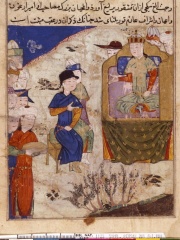
5. Möngke Khan (1209 - 1259)
With an HPI of 82.42, Möngke Khan is the 5th most famous Iraqi Politician. His biography has been translated into 51 different languages.
Möngke Khan (also Möngke Khagan or Möngke; 11 January 1209 – 11 August 1259) was the fourth khagan of the Mongol Empire, ruling from 1 July 1251 to 11 August 1259. He was the first Khagan from the Toluid line, and made significant reforms to improve the administration of the Empire during his reign. Under Möngke, the Mongols conquered Iraq and Syria as well as the kingdom of Dali (modern Yunnan).

6. Ashurbanipal (685 BC - 627 BC)
With an HPI of 80.19, Ashurbanipal is the 6th most famous Iraqi Politician. His biography has been translated into 72 different languages.
Ashurbanipal (Neo-Assyrian Akkadian: 𒀸𒋩𒆕𒀀, romanized: Aššur-bāni-apli, meaning "Ashur is the creator of the heir") was the king of the Neo-Assyrian Empire from 669 BC to his death in 631. He is generally remembered as the last great king of Assyria. Ashurbanipal inherited the throne as his father Esarhaddon‘s favored heir; his 38-year reign was among the longest of any Assyrian king. Though sometimes regarded as the apogee of ancient Assyria, his reign also marked the last time Assyrian armies waged war throughout the ancient Near East and the beginning of the end of Assyrian dominion over the region. Esarhaddon selected Ashurbanipal as heir c. 673. The selection of Ashurbanipal bypassed the elder son Shamash-shum-ukin. Perhaps in order to avoid future rivalry, Esarhaddon designated Shamash-shum-ukin as the heir to Babylonia. The two brothers jointly ascended to their respective thrones after Esarhaddon's death in 669, though Shamash-shum-ukin was relegated to being Ashurbanipal's closely monitored vassal. Much of the early years of Ashurbanipal's reign was spent fighting rebellions in Egypt, which had been conquered by his father. The most extensive campaigns of Ashurbanipal were those directed towards Elam, an ancient enemy of Assyria, and against Shamash-shum-ukin, who gradually began to resent the overbearing control that his younger brother held over him. Elam was defeated in a series of conflicts in 665, 653 and 647–646. Shamash-shum-ukin rebelled in 652 and assembled a coalition of Assyria's enemies but was defeated and died during Ashurbanipal's siege of Babylon in 648. On account of a lack of surviving records, much of Ashurbanipal's late reign is poorly known. Ashurbanipal is chiefly remembered today for his cultural efforts. A patron of artwork and literature, Ashurbanipal was deeply interested in the ancient literary culture of Mesopotamia. Over the course of his long reign, Ashurbanipal utilized the massive resources at his disposal to construct the Library of Ashurbanipal, a collection of texts and documents of various different genres. Perhaps comprising over 100,000 texts at its height, the Library of Ashurbanipal was not surpassed until the construction of the Library of Alexandria, several centuries later. The more than 30,000 cuneiform texts that have survived from the library are a highly important source on ancient Mesopotamian language, religion, literature and science. Artwork produced under Ashurbanipal was innovative in style and motifs and is regarded to possess an "epic quality" otherwise absent from much of the art produced under previous kings. Ashurbanipal is recognized as one of the most brutal Assyrian kings; he was one of the few rulers to boast of his gory massacres of rebellious civilians. His extensive destruction of Elam has been described as a genocide. The Assyrians won many battles under Ashurbanipal, campaigning further from the Assyrian heartland than ever before, but several of his campaigns achieved little strategic advantage. Ashurbanipal failed to maintain control of Egypt, and his wars in Arabia cost time and resources without establishing longterm Assyrian control. His extensive sack of Babylon after defeating Shamash-shum-ukin weakened the resources of the empire and fanned anti-Assyrian sentiment in southern Mesopotamia, perhaps contributing to the rise of the Neo-Babylonian Empire five years after Ashurbanipal's death. Whether Ashurbanipal's policies led to the fall of the Assyrian Empire only two decades after his death is disputed in modern Assyriology. A distorted legend of Ashurbanipal was remembered in Greco-Roman literary tradition under the name Sardanapalus, purportedly the effeminate and decadent last king of Assyria whose vices led to the fall of his empire.

7. Sargon of Akkad (2300 BC - 2215 BC)
With an HPI of 78.68, Sargon of Akkad is the 7th most famous Iraqi Politician. His biography has been translated into 77 different languages.
Sargon of Akkad (; Akkadian: 𒊬𒊒𒄀, romanized: Šarrugi; died c. 2279 BC), also known as Sargon the Great, was the first ruler of the Akkadian Empire, known for his conquests of the Sumerian city-states in the 24th to 23rd centuries BC. He is sometimes identified as the first person in recorded history to rule over an empire. He was the founder of the "Sargonic" or "Old Akkadian" dynasty, which ruled for about a century after his death until the Gutian conquest of Sumer. The Sumerian King List makes him the cup-bearer to King Ur-Zababa of Kish before becoming king himself. His empire, which he ruled from his archaeologically as yet unidentified capital, Akkad, is thought to have included most of Mesopotamia and parts of the Levant, Hurrian and Elamite territory. Sargon appears as a legendary figure in Neo-Assyrian literature of the 8th to 7th centuries BC. Tablets with fragments of a Sargon Birth Legend were found in the Library of Ashurbanipal.

8. Nur ad-Din (1116 - 1174)
With an HPI of 78.41, Nur ad-Din is the 8th most famous Iraqi Politician. His biography has been translated into 45 different languages.
Nūr al-Dīn Maḥmūd Zengī (نور الدين محمود زنگي; February 1118 – 15 May 1174), commonly known as Nur ad-Din (lit. 'Light of the Faith' in Arabic), was a Turkoman member of the Zengid dynasty, who ruled the Syrian province (Shām) of the Seljuk Empire. He reigned from 1146 to 1174. He is regarded as an important figure of the Second Crusade.

9. Nebuchadnezzar I (1200 BC - 1104 BC)
With an HPI of 77.32, Nebuchadnezzar I is the 9th most famous Iraqi Politician. His biography has been translated into 41 different languages.
Nebuchadnezzar I ( NEB-yuu-kəd-NEZ-ər; Babylonian: mdNabû-kudurrī-úṣur (AN-AG-ŠA-DU-ŠIŠ) or mdNábû-ku-dúr-uṣur, meaning "Nabû, protect my eldest son" or "Nabû, protect the border"; reigned c. 1121–1100 BC) was the fourth king of the Second Dynasty of Isin and Fourth Dynasty of Babylon. He ruled for 22 years according to the Babylonian King List C, and was the most prominent monarch of this dynasty. He is best known for his victory over Elam and the recovery of the cultic idol of Marduk.
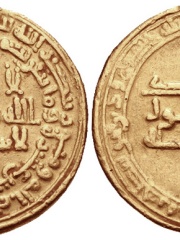
10. Al-Ma'mun (786 - 833)
With an HPI of 77.32, Al-Ma'mun is the 10th most famous Iraqi Politician. His biography has been translated into 55 different languages.
Abū al-ʿAbbās Abd Allāh ibn Hārūn al-Maʾmūn (Arabic: أبو العباس عبد الله بن هارون الرشيد, romanized: Abū al-ʿAbbās ʿAbd Allāh ibn Hārūn ar-Rashīd; 14 September 786 – 9 August 833), better known by his regnal name al-Ma'mun (Arabic: المأمون, lit. 'the Reliable'), was the seventh Abbasid caliph, who reigned from 813 until his death in 833. His leadership was marked by the power and prosperity of the Abbasid Caliphate, al-Ma'mun promoted the Graeco-Arabic translation movement, the flowering of learning and the sciences in Baghdad, and the publishing of al-Khwarizmi's book now known as "Algebra", making him one of the most important caliphs in the Islamic Golden Age. He is also known as a proponent of the rational Islamic theology of Mu'tazilism. Al-Ma'mun succeeded his half-brother al-Amin after a civil war, much of his reign was spent on peace campaigns. His strong support for Mu'tazilism led him to imprison a Sunni Imam, Ahmad ibn Hanbal in an event that became known as mihna. Al-Ma'mun's foreign policy was due to his decision to continue war and diplomatic relations with the Byzantine Empire, the tension between conflict or diplomacy varying during his military campaigns.
People
Pantheon has 207 people classified as Iraqi politicians born between 2850 BC and 1976. Of these 207, 28 (13.53%) of them are still alive today. The most famous living Iraqi politicians include Abdul Latif Rashid, Fuad Masum, and Sajida Talfah. The most famous deceased Iraqi politicians include Saladin, Hammurabi, and Saddam Hussein.
Living Iraqi Politicians
Go to all RankingsAbdul Latif Rashid
1944 - Present
HPI: 73.19
Fuad Masum
1938 - Present
HPI: 70.89
Sajida Talfah
1937 - Present
HPI: 68.81
Nouri al-Maliki
1950 - Present
HPI: 68.49
Ziusudra
HPI: 66.78
Haider al-Abadi
1952 - Present
HPI: 66.12
Barham Salih
1960 - Present
HPI: 64.99
Adil Abdul-Mahdi
1942 - Present
HPI: 64.96
Ibrahim al-Jaafari
1947 - Present
HPI: 64.23
Ayad Allawi
1944 - Present
HPI: 64.22
Muhammad Saeed al-Sahhaf
1940 - Present
HPI: 62.65
Ghazi Mashal Ajil al-Yawer
1958 - Present
HPI: 62.37
Deceased Iraqi Politicians
Go to all RankingsSaladin
1138 - 1193
HPI: 91.36
Hammurabi
1810 BC - 1750 BC
HPI: 86.84
Saddam Hussein
1937 - 2006
HPI: 85.93
Nebuchadnezzar II
630 BC - 562 BC
HPI: 85.35
Möngke Khan
1209 - 1259
HPI: 82.42
Ashurbanipal
685 BC - 627 BC
HPI: 80.19
Sargon of Akkad
2300 BC - 2215 BC
HPI: 78.68
Nur ad-Din
1116 - 1174
HPI: 78.41
Nebuchadnezzar I
1200 BC - 1104 BC
HPI: 77.32
Al-Ma'mun
786 - 833
HPI: 77.32
Alexander IV of Macedon
323 BC - 309 BC
HPI: 76.94
Sennacherib
740 BC - 681 BC
HPI: 76.66
Overlapping Lives
Which Politicians were alive at the same time? This visualization shows the lifespans of the 25 most globally memorable Politicians since 1700.

